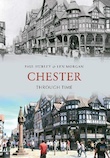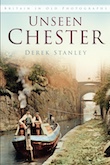Chester has been one of the most photographed British cities over the last one hundred years. Few cities in Britain have changed as little as Chester since the turn of the 19th century. Whilst there has been changes in Chester, the change has been much more subtle than in other UK cities. Thee changes in Chester can be observed by comparison of the thousands of photographic postcards that have been produced over the years.
These postcards can provide hours of entertainment spotting the changes that have taken place. The postally used cards also give an evocative insight into social history and the daily lives of people who have lived and visited Chester over the years.
The postcard was the email or text of the Victorian era! We have placed the message and destination address alongside many of the cards on the site. Take a look at how people went about their daily lives in far more leisurely pace in these postcards. Also note how quickly fashions changed at the turn of the century, both in clothes and methods of transport.
The Cross
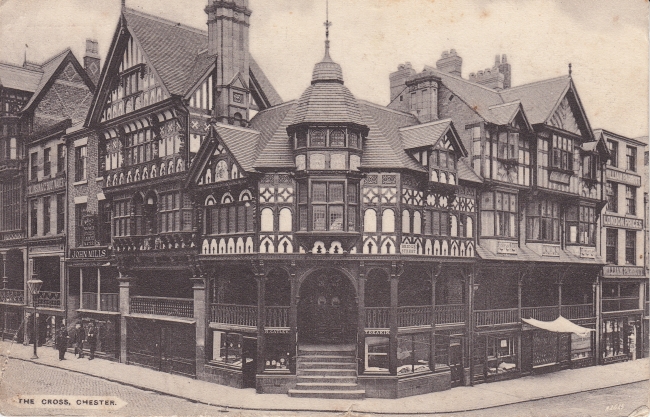
This card posted in 1907 features The Cross at the junction of Foregate Street and Bridge Street. Two policemen and another gentleman can be observed to the left standing on Foregate Street in front of the 'John Mills Pharmaceuticals' business which is also signed as 'Maker of Parfumed Lavender Water'. Other businesses visible on this card are 'Collinson &: Co. Bootmakers', 'R.Catley' who was probably a clock maker given that clocks are on display in his window, 'T. Deakin' and a 'William Parrot' who advertises "London Prices". There is also an unidentified 'Tea &: Coffee Dealer' on Bridge Street.
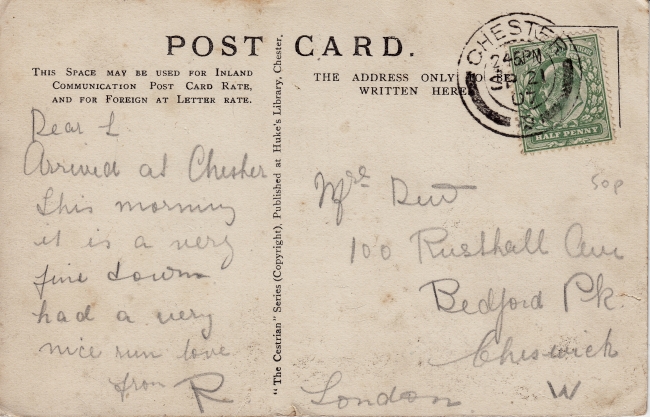
The postcard is addressed to: 100 Rusthall Ave., Bedford Pk., Chiswick, London. And the message reads: Dear L - Arrived at Chester this morning. It is a very fine town. Had a very nice run. Love from R
The City Walls
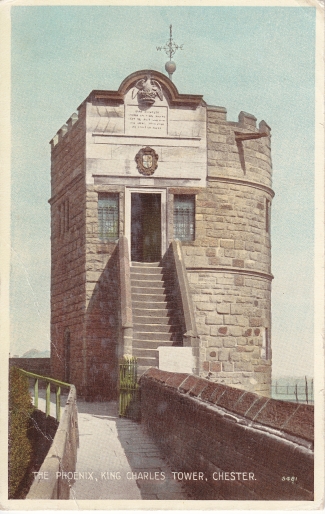
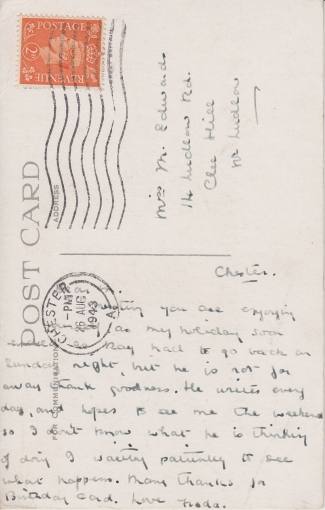
Perhaps one of the most photographed features of Chester's city walls is the Phoenix Tower. More colloquially known as the King Charles Tower, as Charles I is said to have stood atop this tower and watched his Royalist army get defeated by Cromwell's troops at nearby Rowton Moor. Built of red sandstone, the city walls form a circuit of two miles around the old city. The north and east walls follow the line of those of the Roman fortress; the walls on the west and south were moved so that more land could be incorporated within the city's defences.
The card above was posted in 1943 to a Miss M. Edwards, 14 Ludlow Road, Clee Hill, Nr Ludlow. The message on the card reads: "Dear - Trusting you are enjoying yourself as my holiday soon ended as Roy had to go back on Sunday night, but he is not due away thank goodness. He writes every day, and hopes to see me the weekend so I don't know what he is thinking of doing I waiting patiently to see what happens. Many thanks for the Birthday card. Love Freda"
Eastgate

A classic view of the Eastgate Clock on a postcard which was mailed in 1913. The Eastgate, which was the entry point of the Roman road, the Via Devana, was rebuilt as an elegant arch in 1769. The clock standing on top of the Eastgate was presented to the city by Edward Evans-Lloyd in 1897 to commemorate Queen Victoria's diamond jubilee. The clock was made by J B Joyce of Whitchurch, and sits on top of ornate ironwork designed by John Douglas. The building in the foreground on the right of this postcard is the premises of Chester Northgate Brewery Company which has since been demolished and replaced with a half timbered revival building housing the booksellers W H Smith.

This card was published by Hugo Lang & Co. of Liverpool. It does not bear a personal message but was posted in 1913 to: Miss L. Williams, Hill Brow, Bromley, Kent
The River Dee
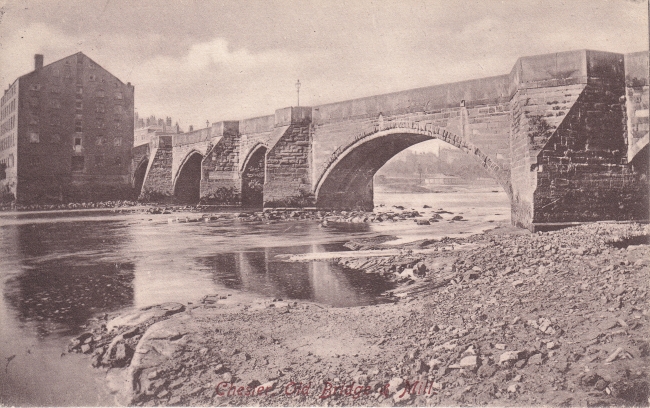
This view looks across the river from Handbridge. The postcard bears a postal mark of 1909 and features the Dee Mills alongside the Old Dee Bridge. The last owners of the Dee Mills were the Wrench family who held them until they closed in about 1895. They will have been demolished not long after this picture was taken and replaced by a hydroelectric power station which still occupies the site today. The weir, which is on the other side of the bridge in this picture, channelled water to the mills. St John's Church can just be seen in the background through the first arch of the bridge, a view that is now obscured by trees and other buildings along the Groves.
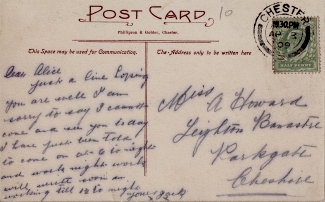
This card was published by Phillipson & Golder of Chester and was posted in 1909 to : Miss A Howarth, Leighton Banastre, Parkgate, Cheshire. It bears the message "Dear Alice - Just a line hoping you are well. I am sorry to say I cannot come and see you today. I have just been told to come on at 6 tonight and work night work. Will visit soon. Working till 12 tonight. Yours G---- xx"
The Cathedral
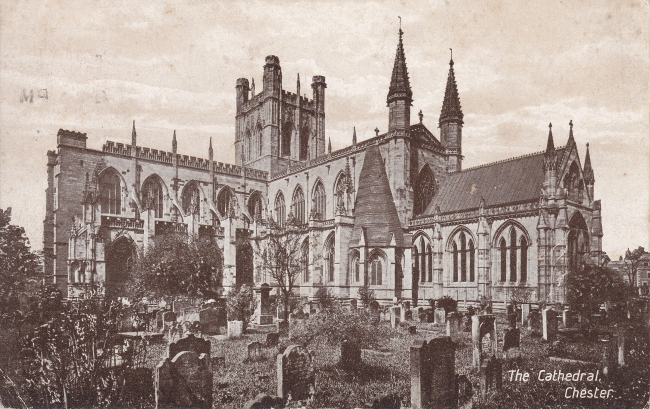
The postal date of this card is unclear but is estimated to be dated around 1912 as it bears a three halfpenny stamp of King George V. This is a much photographed view of the cathedral but note the gravestones in the foreground that have long since been removed. Today the foreground features a garden of remembrance dedicated to the Cheshire Regiment. Also the Addleshaw Bell Tower, erected in 1974, is now in the left foreground of this view.
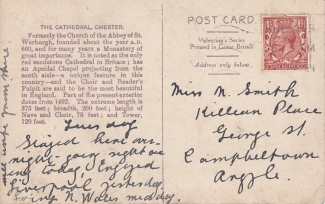
This card was sent to a Miss M. Smith, George Street, Killean Place, Campbeltown, Argyle and the personal message reads: "Tuesday. Stayed here overnight. Going sight seeing today, enjoyed Liverpool yesterday. Going N. Wales midday. Will write from there." The card is from the Valentine's series and includes a brief history and description of the cathedral; "THE CATHEDRAL, CHESTER. Formerly the Church of the Abbey of St. Werburgh, founded about the year A.D.660, and for many years a Monastery of great importance. It is noted as the only red sandstone Cathedral in Britain; has an Apsidal Chapel projecting from the south aisle--a unique feature in this country--and the Choir and Reader's Pulpit are said to be the most beautiful in England. Part of the present exterior dates from 1492. The extreme length is 375 feet; breadth 200 feet; height of Nave and Choir, 78 feet; and Tower, 120 feet."











